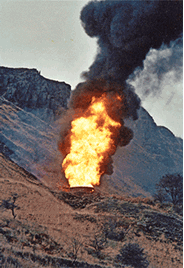AlistairCowell
Member
- Joined
- 10 Jan 2018
- Messages
- 350
It is 40 years ago today that an intensive fire broke out inside the Summit Rail tunnel following a derailment of tank wagons. The train was the 6M08 01:40 Haverton Hill, Teesside to Glazebrook near Warrington, and the train consisted of a Class 47 locomotive numbered 47125 convoying 13 tank wagons loaded with four-star petrol, totalling 835 tons.
The train derailed at 05:50, when the fourth tank wagon suffered a defective roller bearing in the forward axle, which also caused the derailment of several wagons behind, including one of the tankers to fell on its side, causing the petrol leak into the tunnel and this caused a fire along the track. The crew ran the remaining mile to the south portal, where a phone was located, and raised the alarm.
The fire services arrived shortly afterwards to tackle the fire, and at 08:40, the train crew reentered the tunnel and uncoupled the loco and first three still on the rails and were driven out of the tunnel. An hour later, at 09:40, the pressure in one of the heated tankers was hot enough to burst its pressure relief valves, and the fire developed rapidly. The fire crews were evacuated just before the explosion, and the fires were vented out of several ventilation shafts, which could be seen for miles. A major incident was declared at 10:05.
The fire has resulted in the evacuation of 170 nearby residents and the closure of A6033 road between Walsden to Littleborough. Of the evacuated residents, 38 were taken to Walsden Primary School.
The tunnel was closed for eight months for the clearance of fire damaged vehicles and subsequent repairs, and it was not until 19th August 1985 that rail services would resume.
Halifax Courier released the news article this morning:

 www.halifaxcourier.co.uk
www.halifaxcourier.co.uk

 www.railmagazine.com
www.railmagazine.com
The train derailed at 05:50, when the fourth tank wagon suffered a defective roller bearing in the forward axle, which also caused the derailment of several wagons behind, including one of the tankers to fell on its side, causing the petrol leak into the tunnel and this caused a fire along the track. The crew ran the remaining mile to the south portal, where a phone was located, and raised the alarm.
The fire services arrived shortly afterwards to tackle the fire, and at 08:40, the train crew reentered the tunnel and uncoupled the loco and first three still on the rails and were driven out of the tunnel. An hour later, at 09:40, the pressure in one of the heated tankers was hot enough to burst its pressure relief valves, and the fire developed rapidly. The fire crews were evacuated just before the explosion, and the fires were vented out of several ventilation shafts, which could be seen for miles. A major incident was declared at 10:05.
The fire has resulted in the evacuation of 170 nearby residents and the closure of A6033 road between Walsden to Littleborough. Of the evacuated residents, 38 were taken to Walsden Primary School.
The tunnel was closed for eight months for the clearance of fire damaged vehicles and subsequent repairs, and it was not until 19th August 1985 that rail services would resume.
Halifax Courier released the news article this morning:

Remembering the Summit Tunnel Fire 40 years on
We take a look back at the Summit Tunnel Fire, which happened 40 years ago today (Friday, December 20).
You can also read the article about Summit Tunnel from RAIL:Inside the tunnel, between Todmorden and Littleborough, temperatures reached an astonishing 1,530 degrees Celsius.
The Leeds to Manchester railway line was closed for eight months.
Yet amazingly no one, neither railway workers nor firefighters, was hurt and the 143-year-old tunnel - built to last - survived the intense heat remarkably well.

Summit Tunnel: from fire to ice
PAUL STEPHEN recalls the day when a derailed freight train caught fire in Summit Tunnel, which has recently chalked up 175 years of continuous use
The train involved was the 0138 Haverton Hill (Teesside) to Glazebrook (Merseyside) freight train, consisting of 13 tank wagons containing 835 tonnes of petroleum hauled by Class 47 47125. Heading southwards, it entered Summit Tunnel at 0550 on December 20 1984 along the up line at 40mph. Three quarters of a mile inside the tunnel, the fourth and fifth wagons derailed, severing the air brake pipe and triggering an emergency application of the trains’ brakes.
The subsequent accident report compiled by HM Railway Inspectorate found the cause of the derailment to be a catastrophic failure of the fourth wagon’s leading left axlebox roller bearing. The damage caused to the track by the fractured wheelset caused all the following vehicles to derail and fire to break out quickly as leaking petrol was ignited by a hot axlebox.
Blocked by the spreading fire behind them, the train’s three-man crew ran the remaining mile to the tunnel’s south portal where they were able to advise a signaller at Preston Power Signal Box from a signal post telephone that the train was blocking both tracks, carrying petroleum products and that emergency services were required.
Last edited by a moderator:
